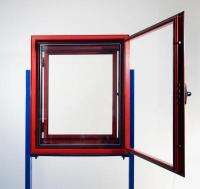Researchers develop new reversible, green window technology

Ben-Gurion University of the Negev (BGU, Israel) researchers have developed a new, highly energy-efficient window technology, featuring two reversible panes that will save energy all year round in homes and office buildings.
"The 'Seasons Window' features the only glazing system that permits effective passive heating in winter without glare or high radiant temperature near a window and reduces unwanted solar gains in summer without obstructing the view outdoors," explains Prof. Evyatar Erell, a researcher at BGU's Jacob Blaustein Institutes for Desert Research.
The reversible window system technology features two panes: one clear, airtight pane, and a smaller, tinted glass with an opening on top and bottom, which allows air to circulate between the panes. The window panes are fixed to a single frame and can be swiveled easily during seasonal changes - or even on a daily basis, in response to changing weather. The window system is intended for buildings in sunny regions with distinct hot and cold seasons.
In winter, short wave solar radiation is transmitted through the clear glass, and is absorbed by the tinted glass which faces indoors. The interior is heated in two ways: by long wave radiation emitted from the warm tinted pane, and by heating of the air in contact with the warm glass, which flows through the gap between the panes and returns to a room as much a 20°c. warmer. The clear pane -- preferably double-glazed with a low-E (emittance) coating -- traps heat inside the building.
In summer, the glass panes are easily rotated so the tinted glass faces outward and absorbs the warm solar rays. This pane is then cooled by the outside air circulating between the two panes. The clear glass pane, which is on the interior, absorbs unwanted infrared radiation from the warmer exterior pane and helps to reduce a building's cooling loads.
According to co-developer and BGU Prof. Yair Etzion, "The heat lost in houses in various regions depends on both climate and on design and construction." A common indicator is energy required to heat or cool a building, per unit floor area per year, with values ranging from zero to more typical values of 150-300 kilowatts in many older buildings in the United States and Europe. "By converting solar radiation into heat, our new green window solution conserves energy and saves money over time."
The windows will be produced and marketed in Israel by Alubin, an aluminum company.
Source: American Associates, Ben-Gurion University of the Negev





















